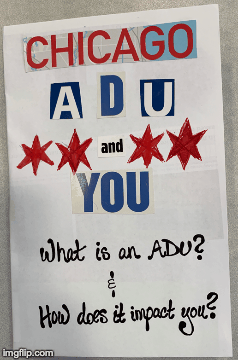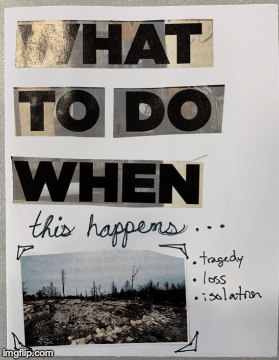Spring 2019 – Workshop #3: The Grassroots Art of Zine Making
On Wednesday 3/13, we gathered at The Great Cities Institute at UIC to learn about the grassroots art of zine (pron: 'zeen') making which enables information sharing in an affordable way. Vitaly Vladimirov led us through a workshop where we rolled up our sleeves, uncorked the glue sticks, and destroyed a stack of magazines all in the name of advocating for ADUs in Chicagoland. [Fun fact: there is a legit zine scene in Chicago.]
Season Theme: Accessory Dwelling Units
Workshop Method: Zines as a DYI Resource to Share Information


Photos by Lindsey Conklin
Vitality Vladimirov is an urban planner who began making zines as a way to get people to remember what he taught on his walking tours. He didn’t have a lot of resources but he had knowledge, time, and the ability to create a physical resource. With every zine, his goal is to mix urban theory, social science research, census data, and the ideals of spatial justice to recruit others as allies. A few of the topics he’s covered include: Redlining, Segregation, Justice, Land Use, Mobility, Parking, LGBT Politics, and the Uptown Neighborhood.

Photo by Paola Aguirre
*Step 1: Define Your Audience - Who’s your audience?
Isolate who you are trying to reach with your zine (the audience) and why they should care. Understanding your audience is the key to how you will begin your zine. Are they novices or experts on the topic you want to present? Are they new to the city or long-time residents? These details will help you refine your message.

Photo by Lindsey Conklin
*Step 2: Storyboard the Content - What key takeaway do you want to leave the audience with?
Zines can be folded in a variety of ways so it's important to first establish how many sections you have in order to create the structure. Next, you will visually block out the content as you ask yourself, what is the story you want to tell? Vitaly recommends doing the storyboarding quickly in order to get it all out on the page. He also recommends you stay flexible because the end result will often be different from what you thought. And, finally, you will want to go back and edit your storyboard so that only the most important information remains.


Photos by Lindsey Conklin
*Step 3: Use Numbers and Narratives -What type of data will support the key takeaway?
Make sure to support your key takeaway using facts and figures such as social science research or census data. Combined with urban theory, this data is powerful and will help support your message. Include maps, drawings, or photos to help make it visually appealing.


Photos by Lindsey Conklin
*Step 4: Give a Call to Action
End with next steps such as a list of further reading or non-profits to support so that the reader has an easy way to follow through and become an ally to your cause.

Photo by Lindsey Conklin
Special thanks to Vitaly Vladimirov for creating the Zine Making Workshop.
You can find notes from this workshop here. And behold our final ADU zines:




LINDSEY CONKLIN is an anthropologist and researcher who works at the intersection of social impact design, the built environment, and community development.














